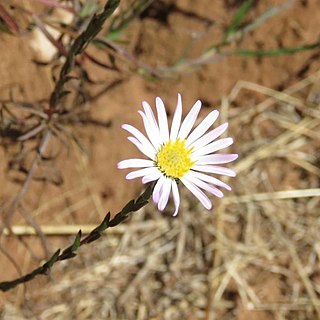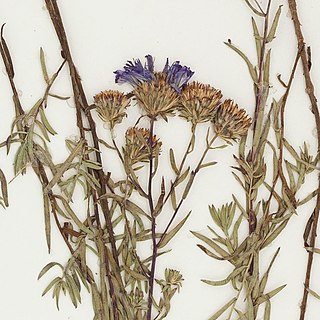
Symphyotrichum is a genus of over 100 species and naturally occurring hybrids of herbaceous annual and perennial plants in the composite family, Asteraceae, most which were formerly treated within the genus Aster. The majority are endemic to North America, but several also occur in the West Indies, Central and South America, as well as one species in eastern Eurasia. Several species have been introduced to Europe as garden specimens, most notably New England aster and New York aster.

Ericameria nauseosa, commonly known as chamisa, rubber rabbitbrush, and gray rabbitbrush, is a shrub in the sunflower family (Aster) found in the arid regions of western North America.

Canadanthus is a North American monotypic genus of flowering plants in the family Asteraceae. The only species is Canadanthus modestus, commonly known as great northern aster or western bog aster. It is native to most of Canada and to northern parts of the United States.

Laennecia or Laënnecia is a genus of flowering plants in the family Asteraceae. The plants are native to Mesoamerica, South America, and the southwestern United States. Common name is "horseweed."
Toiyabea is a genus of North American plants in the tribe Astereae within the family Asteraceae. The genus is named for the Toiyabe Mountains in the US state of Nevada.
Xylothamia, the desert goldenrods, is a genus of flowering plants in the family Asteraceae. Until 2003, it was held to contain nine species of shrubs native to deserts of Mexico and the southwestern United States. However, it seems to contain at least two groups. Four species are related to Gundlachia and may be moved to that genus. Plants of the World Online class it as a synonym of Gundlachia. The relationships of the other five species is not quite as clear. All nine species do belong in the subtribe Solidagininae.
Eurybia horrida is a species of flowering plant in the family Asteraceae known by the common names spiny aster and horrid herrickia. It is native to Colorado and New Mexico in the United States, where it occurs only in the Canadian River basin. It most often included in genus Eurybia.
Guy L. Nesom is an American writer and botanist.
Tomentaurum niveum is a species of flowering plant in the family Asteraceae, native to the states of Sonora and Chihuahua in northern Mexico. It was first described by Sereno Watson in 1888 as Haplopappus niveus.

Eurybia glauca is a North American species of flowering plants in the family Asteraceae, called the gray aster. It is native to the western United States, primarily in Arizona, New Mexico, Utah, Colorado, and Wyoming, with a few populations in Idaho and Montana.

Eurybia kingii is a North American species of flowering plants in the family Asteraceae, called the King's serpentweed or King's aster. It has been found only in the State of Utah in the western United States.

Sanrobertia is a genus of flowering plants within the subtribe Symphyotrichinae of the family Asteraceae. It is monotypic, meaning there is only one species within the genus. Sanrobertia gypsophila is a rare endemic known only from Nuevo León, Mexico.
Aquilula is a genus of flowering plants belonging to the family Asteraceae. It contains a singles species, Aquilula riskindii.

Symphyotrichum hintonii is a species of perennial, herbaceous, flowering plant in the family Asteraceae native to Guerrero, Mexico. It grows in oak and oak-pine woods at elevations of 1,400–2,200 meters, blooming white ray florets November–January. It reaches heights of about 40–80 centimeters.

Symphyotrichum moranense is a species of flowering plant in the family Asteraceae. It is a perennial and herbaceous plant that reaches about 90 centimeters in height. Its white ray florets open October through April, and it is native to Mexico.

Symphyotrichum bimater is a species of flowering plant in the family Asteraceae that is native to the states of Chiapas and Oaxaca in Mexico, and to Guatemala. It is perennial and herbaceous and grows to heights of 30–46 centimeters. Its white ray florets bloom May–December, and it grows in pine-oak woods, ravines, slopes, and grassy openings at elevations 1,000–2,150 meters.

Symphyotrichum chihuahuense is a species of flowering plant in the family Asteraceae that is native to Chihuahua and Durango, Mexico. It is perennial and herbaceous and reaches heights of 20–35 centimeters. Its white ray florets open June–September, and it grows in grasslands and oak–pine woods at elevations 1,800–2,500 meters.

Symphyotrichum purpurascens is a species of flowering plant in the family Asteraceae native to areas of Mexico and Guatemala.

Symphyotrichum turneri is a species of flowering plant in the family Asteraceae native to Durango, Mexico.












